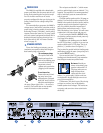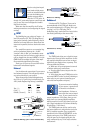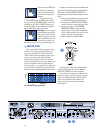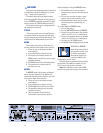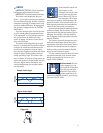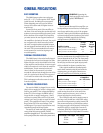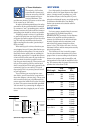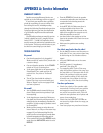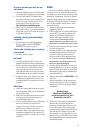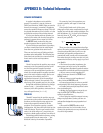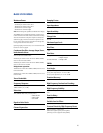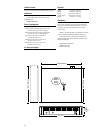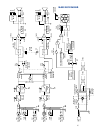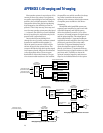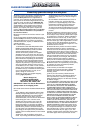20
• Turn the
POWER
off, check the speaker
connections and make sure that there are
no strands of wire shorting across the
speaker terminals.
• Is the
HOT
LED lit? Make sure there is
cool air available at the front of the
amplifier. Make sure there is room at the
sides of the amplifier for warm air to exit.
Allow the amplifier to cool off.
• Are there fuses in the speaker or in-line
fuses in the speaker wire? Check ’em to see
if they’re blown.
• Make sure the speakers are working
properly.
One side is way louder than the other!
• Do the M•800’s meters read the same on
both sides? If not, your source signal may
be delivering an out-of-balance stereo
signal.
• Are both
GAIN
knobs set to the same
position?
• Are the speaker(s) impedances
matched? (See page 22)
• Try swapping sides: Turn off the amp,
swap the speaker cables at the amp, turn
the amp back on. If the same side is still
louder, the problem is with your speak-
ers or speaker cabling. If the other side
is louder now, the problem is with the
mixer, the amp, or the line-level cabling.
Poor bass performance
• Check the polarity of the speaker cable
connections. You may have your positive
and negative connections reversed at
one end of one speaker cable. This will
make the two speakers out-of-phase and
cause a bass reduction.
• Check that the
LOW CUT FILTERs
are
not turned up higher than the range you
want to hear.
• Your bass player may need more lessons.
WARRANTY SERVICE
Details concerning Warranty Service are
spelled out in the Warranty section on page 27.
If you think your amplifier has a problem,
please do everything you can to confirm it be-
fore calling for service, including reading
through the following Troubleshooting section.
Doing so might save you from the deprivation
of your Mackie amplifier and the associated
suffering.
Of all Mackie products returned for service
(which is hardly any at all), roughly 50% are
coded “CND” — Could Not Duplicate, which
usually means the problem lay somewhere else
in the system. These may sound obvious to you,
but here are some things you can check:
TROUBLESHOOTING
No power!
• Our favorite question: Is it plugged in?
Make sure the AC outlet is live (check with
a tester or lamp).
• Our next favorite question: Is the
POWER
switch on? If not, try turning it on.
• Is the green light next to the power switch
illuminated? If not, make sure the AC
outlet is live. If so, refer to “No Sound”
below.
• The AC line fuse inside the cabinet is
blown. This is not a user-serviceable part.
Refer to “Repair” on the next page to find
out how to proceed.
No sound!
• Are the
GAIN
controls turned all the way
down? Slowly turn them up and see if you
hear anything.
• Is the signal source turned up? Make sure
the signal level from the mixing console (or
whatever device immediately precedes the
amplifier) is high enough to produce sound
in the amplifier.
• Make sure the preamp or mixer does not
have a Mute on, or a Tape or Processor loop
engaged. If you find something like this,
make sure the volume/gain is turned down
before disengaging the offending switch.
• If the speakers are wired for
BRIDGE
mode,
make sure the
AMP MODE
switch is set to
BRIDGE
.
APPENDIX A: Service Information



